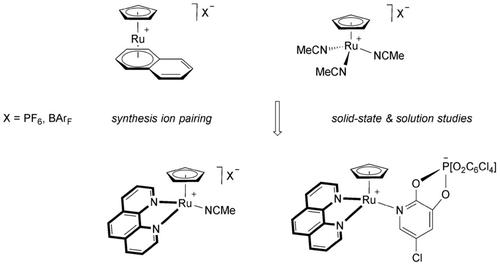当前位置:
X-MOL 学术
›
Helv. Chimica Acta
›
论文详情
Our official English website, www.x-mol.net, welcomes your
feedback! (Note: you will need to create a separate account there.)
Preparation and Structural Characterization of [CpRu(1,10‐phenanthroline)(CH3CN)][X] and Precursor Complexes (X=PF6, BArF, TRISPHAT‐N)
Helvetica Chimica Acta ( IF 1.5 ) Pub Date : 2020-10-23 , DOI: 10.1002/hlca.202000190 Thierry Achard 1 , Léo Egger 1 , Cecilia Tortoreto 1 , Laure Guénée 2 , Jérôme Lacour 1
Helvetica Chimica Acta ( IF 1.5 ) Pub Date : 2020-10-23 , DOI: 10.1002/hlca.202000190 Thierry Achard 1 , Léo Egger 1 , Cecilia Tortoreto 1 , Laure Guénée 2 , Jérôme Lacour 1
Affiliation

|
Cationic [Ru(η5‐C5H5)(CH3CN)3]+ complex, tris(acetonitrile)(cyclopentadienyl)ruthenium(II), gives rise to a very rich organometallic chemistry. Combined with diimine ligands, and 1,10‐phenanthroline in particular, this system efficiently catalyzes diazo decomposition processes to generate metal‐carbenes which undergo a series of original transformations in the presence of Lewis basic substrates. Herein, syntheses and characterizations of [CpRu(Phen)(L)] complexes with (large) lipophilic non‐coordinating (PF6− and BArF−) and coordinating TRISPHAT‐N− anions are reported. Complex [CpRu(η6‐naphthalene)][BArF] ([1][BArF]) is readily accessible, in high yield, by direct counterion exchange between [1][PF6] and sodium tetrakis[3,5‐bis(trifluoromethyl)phenyl]borate (NaBArF) salts. Ligand exchange of [1][BArF] in acetonitrile generated stable [Ru(η5‐C5H5)(CH3CN)3][BArF] ([2][BArF]) complex in high yield. Then, the desired [CpRu(Phen)(CH3CN)] ([3]) complexes were obtained from either the [1] or [2] complex in the presence of the 1,10‐phenanthroline as ligand. For characterization and comparison purposes, the anionic hemilabile ligand TRISPHAT−N (TTN) was introduced on the ruthenium center, from the complex [3][PF6], to quantitatively generate the desired complex [CpRu(Phen)(TTN)] ([4]) by displacement of the remaining acetonitrile ligand and of the PF6− anion. Solid state structures of complexes [1][BArF], [2][BArF], [3][BArF], [3][PF6] and [4] were determined by X‐ray diffraction studies and are discussed herein.
中文翻译:

[CpRu(1,10-菲咯啉)(CH3CN)] [X]和前体配合物(X = PF6,BArF,TRISPHAT‐N)的制备和结构表征
阳离子的[Ru(η 5 -C 5 H ^ 5)(CH 3 CN)3 ] +络合物,三(乙腈)(环戊二烯基)钌(II),产生了非常丰富的有机金属化学。该系统与二亚胺配体(尤其是1,10-菲咯啉)结合使用,可有效催化重氮分解过程,生成金属卡宾,在路易斯碱性底物存在下,卡宾会经历一系列原始转化。本文中,[CPRU(phen)的(L)]的合成和表征与(大)的亲脂性非配位复合物(PF 6 -和酒吧˚F - )和协调TRISPHAT-N -据报道有阴离子。络合物[CPRU(η 6 -萘)] [BAR ˚F ]([1] [巴˚F ])是容易访问的,以高收率,通过之间的直接交换抗衡离子[1] [PF 6 ]和钠四[3,5- -双(三氟甲基)苯基]硼酸盐(NaBAr F)盐。配体的交换[1] [巴˚F ]在乙腈中产生稳定的[Ru(η 5 -C 5 H ^ 5)(CH 3 CN)3 ] [巴˚F ]([2] [巴˚F ])以高收率复杂。然后,所需的[CpRu(Phen)(CH 3CN)]([3])络合物是在[1]或[2]络合物中以1,10-菲咯啉作为配体存在的。为了进行表征和比较,将阴离子半不稳定的配体TRISPHAT-N(TTN)从配合物[3] [PF 6 ]引入钌中心,以定量生成所需的配合物[CpRu(Phen)(TTN)]([4]由剩余的乙腈配体和PF的位移)6 -的阴离子。配合物[1] [BAr F ],[2] [BAr F ],[3] [BAr F ]的固态结构,[3] [PF 6 ]和[4]是通过X射线衍射研究确定的,并在本文中进行了讨论。
更新日期:2020-12-11
中文翻译:

[CpRu(1,10-菲咯啉)(CH3CN)] [X]和前体配合物(X = PF6,BArF,TRISPHAT‐N)的制备和结构表征
阳离子的[Ru(η 5 -C 5 H ^ 5)(CH 3 CN)3 ] +络合物,三(乙腈)(环戊二烯基)钌(II),产生了非常丰富的有机金属化学。该系统与二亚胺配体(尤其是1,10-菲咯啉)结合使用,可有效催化重氮分解过程,生成金属卡宾,在路易斯碱性底物存在下,卡宾会经历一系列原始转化。本文中,[CPRU(phen)的(L)]的合成和表征与(大)的亲脂性非配位复合物(PF 6 -和酒吧˚F - )和协调TRISPHAT-N -据报道有阴离子。络合物[CPRU(η 6 -萘)] [BAR ˚F ]([1] [巴˚F ])是容易访问的,以高收率,通过之间的直接交换抗衡离子[1] [PF 6 ]和钠四[3,5- -双(三氟甲基)苯基]硼酸盐(NaBAr F)盐。配体的交换[1] [巴˚F ]在乙腈中产生稳定的[Ru(η 5 -C 5 H ^ 5)(CH 3 CN)3 ] [巴˚F ]([2] [巴˚F ])以高收率复杂。然后,所需的[CpRu(Phen)(CH 3CN)]([3])络合物是在[1]或[2]络合物中以1,10-菲咯啉作为配体存在的。为了进行表征和比较,将阴离子半不稳定的配体TRISPHAT-N(TTN)从配合物[3] [PF 6 ]引入钌中心,以定量生成所需的配合物[CpRu(Phen)(TTN)]([4]由剩余的乙腈配体和PF的位移)6 -的阴离子。配合物[1] [BAr F ],[2] [BAr F ],[3] [BAr F ]的固态结构,[3] [PF 6 ]和[4]是通过X射线衍射研究确定的,并在本文中进行了讨论。











































 京公网安备 11010802027423号
京公网安备 11010802027423号